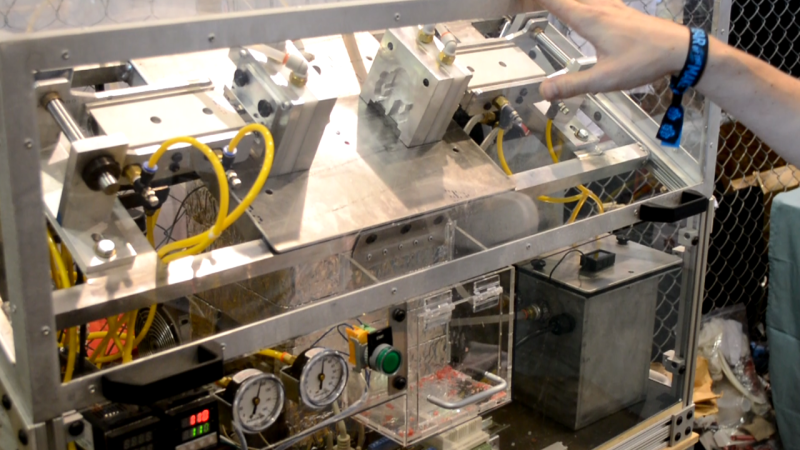[youtube=https://www.youtube.com/watch?v=2P7MaZUrSQQ&w=580]
We caught up with [James Durand] at Maker Faire. He was one of the rare Makers (no mention of selling or future crowd funding) that had a booth at Maker Faire — he was exhibiting a blow molding machine that he built from scratch.
The fabrication process is 100% [James]. Every custom part was designed and milled by him. All of the assembly techniques were his to learn along the way. And we didn’t see anything that isn’t production ready. We’re both impressed and envious.
About three years ago he got the itch to build the mini-molder after learning about the Mold-A-Rama machine — a blow-molding vending machine that was popular a half century ago. A bit of his journey is documented as a molding category on his blog. For the most part it sounds like 1.5 years spent on the CAD design really paid off. He did share one element that required redesign. The initial prototype had a problem with the molds being pushed up when they came together. He tweaked the mechanism to close with a downward motion by flipping the hinge design. This seems to hold everything in place while the drinking fountain chiller and water pump cool the mold and the plastic model within.

















wheres the video, instant private!?
You have to set videos as private on YouTube in order to schedule them for publishing. I make a time-zone error (just got back home from CA and my brain didn’t reset, I guess). Sorry!
Also… ” a molding category on his blog.” leads to the Wikipedia Mold-O-Rama link as well…..
Thanks, fixed.
Can you fix the crappiest camerawork known to man?
i think this is the video you are looking for:
https://www.youtube.com/watch?v=2P7MaZUrSQQ
also i think this is the link to his blog category on the build:
http://ashermade.com/category/mini-molder/
That is impressive. Wow.
The title is misleading, this is blow-molding, not injection molding.
A very cool machine nonetheless.
For sufficiently small items, this could easily be used for injection molding, just no air puff at the end.
No it is injection molding. So is the mold-a-rama machine that they were inspired by.
This brings back fond memories of as a kid watching little “King Kong” model figures getting made on the commercial machines. Great stuff.
Why does the title and article read blow molding when the creator says in the video & the youtube title clearly says injection molding. Injection molding is totally different than blow molding. This is his website. http://ashermade.com/category/mini-molder/
The title here said injection molding originally. I guess it was changed in response to a complaint that said it was blow molding.
It’s injection molding. Not really close to the process of blow molding other than it results in a hollow product.
According to the builder’s description in the video, the molten plastic is injected then the mold is chilled long enough to create a thin shell of solidified plastic. Then the remaining molten plastic is removed from inside that shell. The removal of the remaining molten plastic is aided by air pressure, but I don’t believe that justifies calling this a blow molding process.
Also you reference the Mold-a-rama as a blow molding machine which it isn’t either. It is an injection molding machine. I know Wikipedia says it’s a blow molding machine but I’m afraid Wiki is also incorrect. There are several videos on YouTube of the mold-a-rama in action and you can see the process in action.
Ah here is the confusion. The mold-a-rama was a hybrid injection blow molder. What isn’t clear is what these guys are doing. This site better explains the process of the mold-a-rama. So you use injection molding to fill the mold, and air to make it hollow. A blending of both processes. It should read injection-blow molding. http://ashermade.com/2010/09/12/diy-mold-a-rama-how-it-works/
Is there still one of those machines at the Griffith Park observatory? I was there in 1986 or 1987 and it had a Space Shuttle mold.
“He was one of the rare Makers (no mention of selling or future crowd funding) that had a booth at Maker Faire”
Having been one of those makers that was not selling or crowd funding at a Maker Faire, by the end of the day I was wondering to myself what I was doing there. It was interesting talking to people about my projects for about the first hour, but after that it got really old. It does seem like a good question, why? I’m still trying to come up with a good answer.
All creative projects eventually get diluted by competitive exclusion. You are likely trying to work cooperatively to improve your understanding of things, while lower functioning individuals are primarily motivated by reward incentives.
Unfortunately the ends justify the means in the real world, and success is defined by most people as having acquired notoriety or a monetary sum.
Prepare yourself, there are far more retards on this earth than can accurately be counted.
The chances of you running into fellow hobbyist blow mold fabricators at such an event is very low. At least with the internet, fellow blow mold fabricator enthusiasts can meet up and talk, exchange ideas, etc.
Impressive and exceptional neat work, congratulations!
HI that is impressive I work blow mounding and molding machine so I would like to know more about this machine
Impressive and exceptional neat work, congratulations!
contact me please
I am the Department Chair of Applied Technologies at a community college. I was a mold maker before becoming an educator. Would you consider sharing your information? I would like to see this as a departmental project.
Thanks,